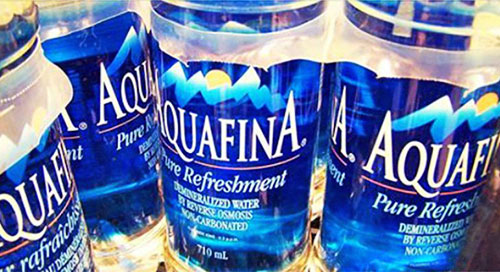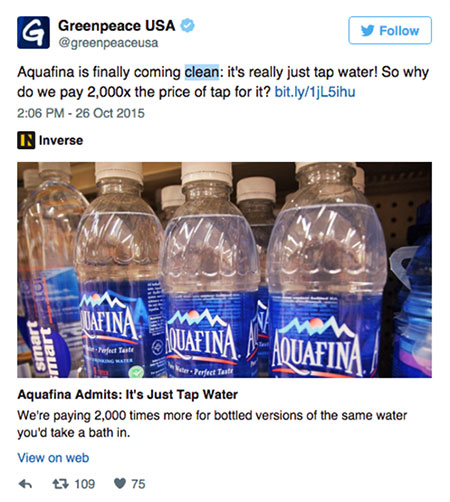|

by Arjun Walia
January 25, 2016
from
Collective-Evolution Website

Bottled water is one of the greatest
marketing scams of the modern age.
Take PepsiCo's
Aquafina brand, for
example. Just by including a picture of mountains on the label, we
are led to believe that this water originates from a natural
drinking source. It's essentially the same tactic that is used by
several
companies who bottle and sell water to the masses, as well
as by food manufacturers who wish us to believe their products are
'natural.'
Pepsico recently admitted that Aquafina
is really just tap water, so ask yourself, why do we pay 2,000x the
price of tap for it?
Nestle's
Pure Life and Coca-Cola's
Dasani, the world's largest corporate water brands, are also guilty
of this kind of willful misdirection. Three years ago, Coca-Cola
admitted that Dasani is just filtered tap water.
In 2007,
Corporate Accountability
International, based in Boston, pressured the U.S. manufacturer of Aquafina bottled water to make it clear that the drink is made with
treated tap water.
They said that PepsiCo was guilty of
misleading marketing practices used to,
"turn
water from a natural resource into a pricey consumer item."
Although this effort began several
years, activists are still pressuring the company to label all of
their bottles with something that, truly, should be public
knowledge.
"New labels will spell out 'public water
source,' acknowledging the bottled brand's shared origin
with tap water. Aquafina is then purified through a seven-step
process, stripping it of minerals and other contents commonly
found in municipal water supply."
source
So, it seems not all of the bottles were
labeled, which is why RT news as well as Greenpeace have also joined
in to contribute to the bad press for bottled water, and we are
happy to do the same.
It's just another opportunity to provide
the masses with the truth about bottled water.

Important Facts
About Bottled Water
1.
Bottled Water is More Expensive Than Tap Water
According to
Business Insider, the bottled water industry,
"grossed a total of $11.8
billion on 9.7 billion gallons (of water) in 2012, making
bottled water about $1.22/gallon nationwide and 300x the
cost of a gallon of tap water.
If we take into account the fact
that almost 2/3 of all bottled water sales are single 16.90z
(500mL) bottles, though, this cost is much, much higher:
about $7.50 per gallon, according to the American Water
Works Association.
That's almost 2,000x the
cost of a gallon of tap water and twice the cost of a gallon
of regular gasoline."
The article goes on to mention
several other shocking statistics, like the fact that bottled
water consumption and sales have increased approximately 350%
respectively since the tracking of the dollar amounts in 1991.
In that year alone, Americans spent
$2.5 billion on 2.4 billion gallons (about $1.07/gallon).
The plastic bottles of water we buy
every week in the United States alone could circle the globe
five times.
That's not a comfortable thought,
and it should have us questioning our activities on the planet,
and whether or not the convenience is worth the cost in
ecological damage.
2.
Potentially Harmful
Chemicals In Bottled Water
Truth is, it takes a lot of oil to
make plastic bottles.
The amount of oil it takes to make
plastic water bottles in the United States alone could fuel
approximately one million cars and light trucks for a year. (source)
Not long ago, German researchers
discovered endocrine disrupting chemicals (EDCs), that could
adversely affect development and reproduction, to be contained
in 18 popular name brand bottled water products.
Of the 24,520 suspect chemicals
found to be present in bottled water, the one that showed
consistent results and illustrated anti-androgenic and
anti-estrogenic activity was bis(2-ethylhexyl) fumarate (DEHP).
Endocrine disruptors are chemicals
that can interfere with the hormone system; they can cause
cancerous tumors, birth defects, cardiovascular disorders,
metabolic disorders, and, as mentioned earlier, other
developmental disorders.
"An increasing number of in vitro studies
reports the presence of EDCs in bottled water. [12], [13], [14], [15], [17]
With previous studies focusing on
estrogenicity, the present work provides evidence for an
additional contamination with steroid receptor antagonists.
Using an optimized extraction procedure, we detected
antiestrogens and antiandrogens in the majority of analyzed
bottled water products.
Moreover, the antagonist activity was very
potent. An equivalent of 3.75 ml. bottled water inhibited
estrogen and androgen receptor by up to 60 and 90%,
respectively...
From a broader perspective,
bottled water from six different countries has been found to
contain estrogenic,
[12], [13], [14], [15], [17] antiestrogenic, and antiandrogenic (this study), as well as
androgenic, progestagenic, and glucocorticoid-like
chemicals. [16]
This demonstrates that a popular beverage is
contaminated with diverse-acting EDCs."
(Identification
of Putative Steroid Receptor Antagonists in Bottled
Water - Combining Bioassays and High-Resolution Mass
Spectrometry)
Researchers used spectrometric
simulation to narrow down their findings to DEHP as the only
possible EDC giving rise to harmful activity.
DEHP is also known as an
anti-estrogenic compound, which means that another unidentified
EDC must be present in the samples that showed anti-androgenic
activity
3. Bottled
Water Could Potentially Be of Lower Quality Than Tap Water
Not long ago the city of Cleveland
conducted a test on the Fiji Water brand and discovered that
their water actually contained traces of arsenic, while the
city's own water supply did not.
How is this possible?
"Bottled water manufacturers are not required
to disclose as much information as municipal water utilities
because of gaps in federal oversight authority, according to
reports released yesterday by government auditors.
Bottom line: The Food and Drug Administration
(FDA)
oversees bottled water, and U.S. EPA is in charge of tap
water. FDA lacks the regulatory authority of EPA, John
Stephenson of the Government Accountability Office told a
House panel."
Sarah Goodman of the
New York Times
The list is a long one, and it's pretty
ridiculous when you think about the fact that there are almost
one
billion people on this planet who do not have access to clean
drinking water.
More frustrating still is the reality
that it doesn't need to be this way.
Children are dying by the minute from
waterborne diseases and we have spent billions of dollars trying to
vaccinate these populations, yet the same level of effort is not
being made to provide clean drinking water to various communities
around the world.
Our greed seems to be the source of this
problem…
|



